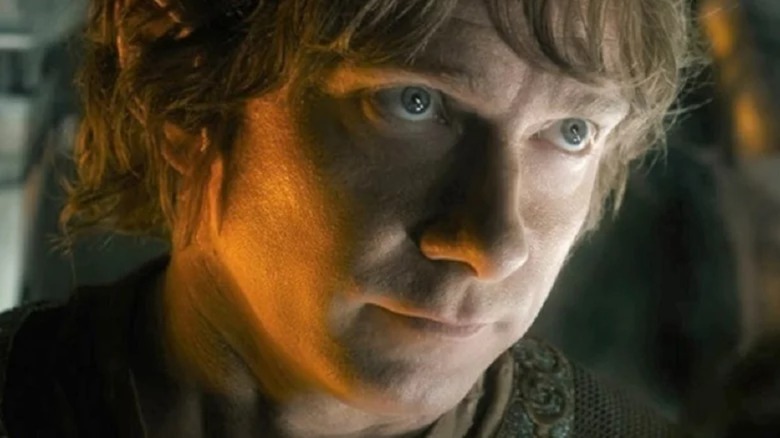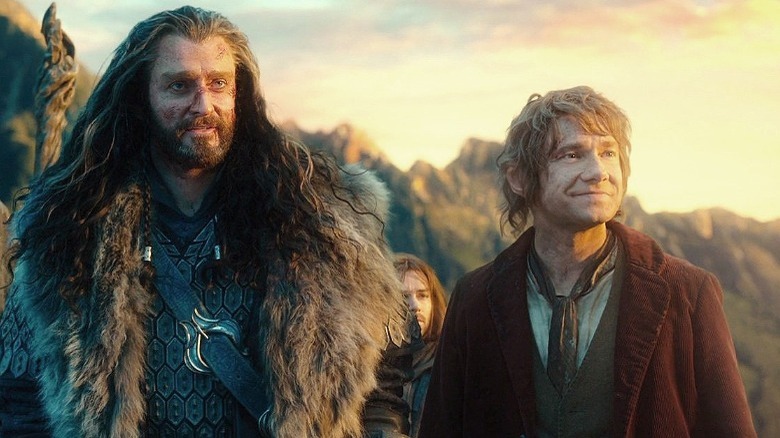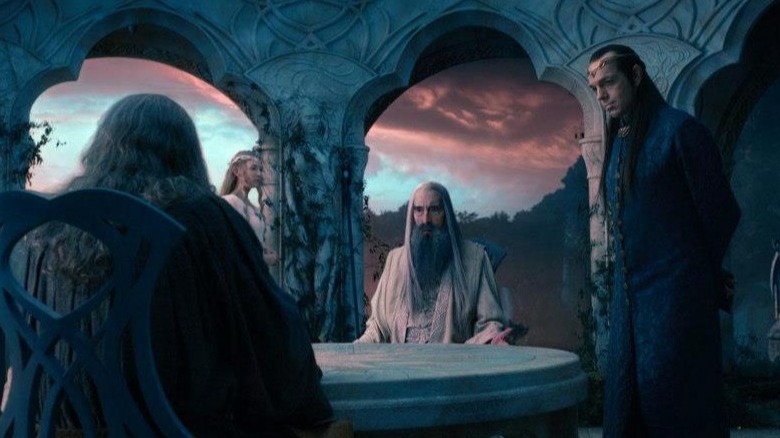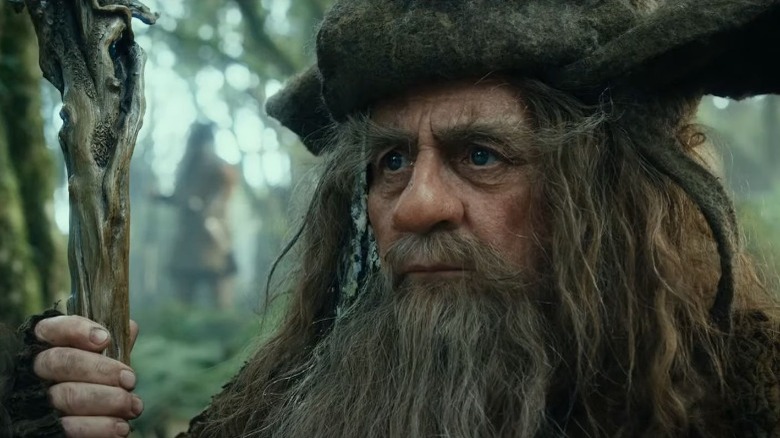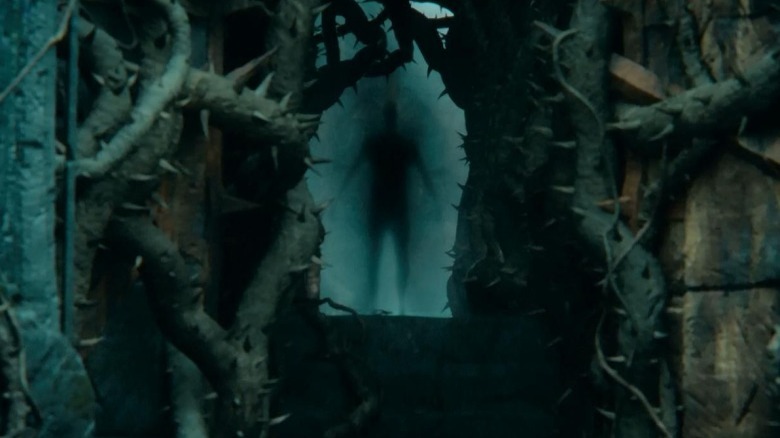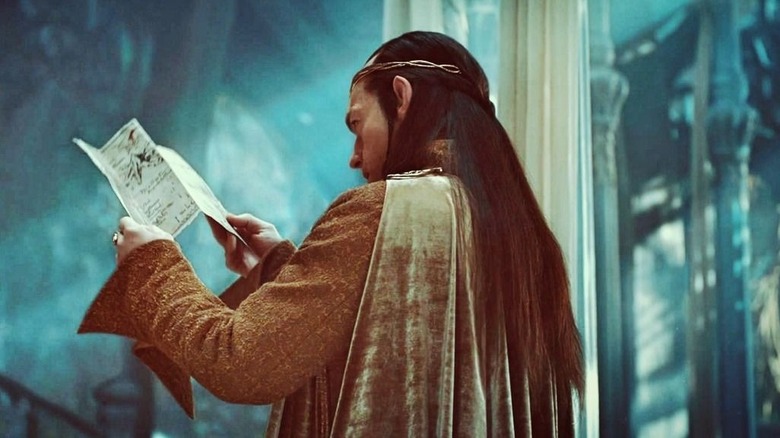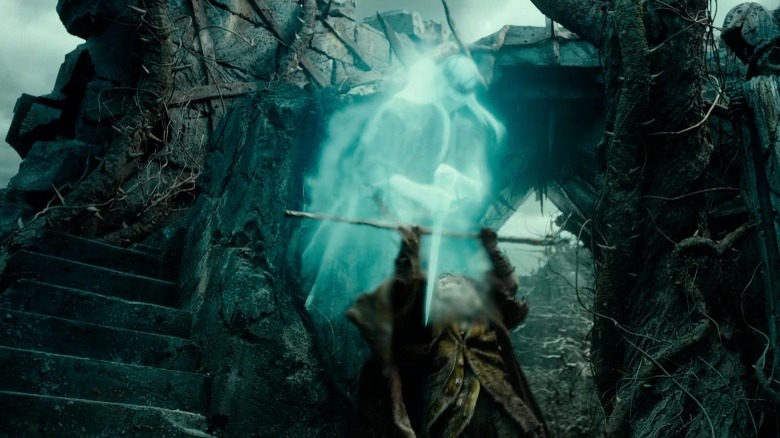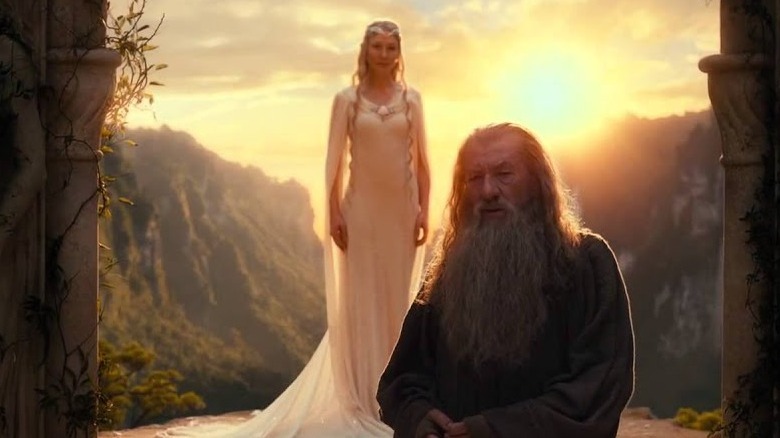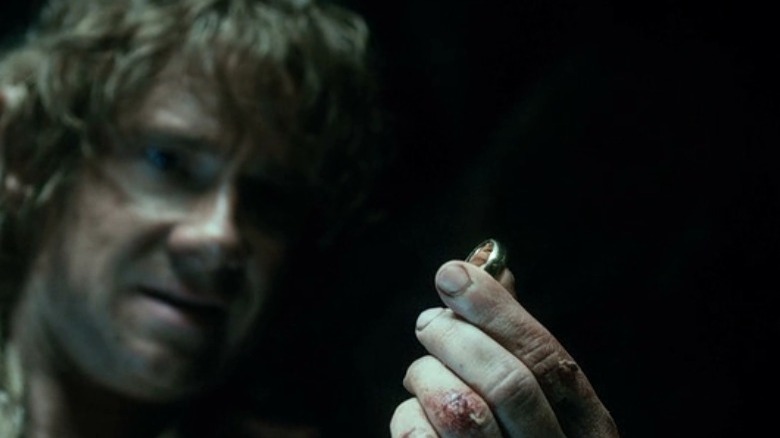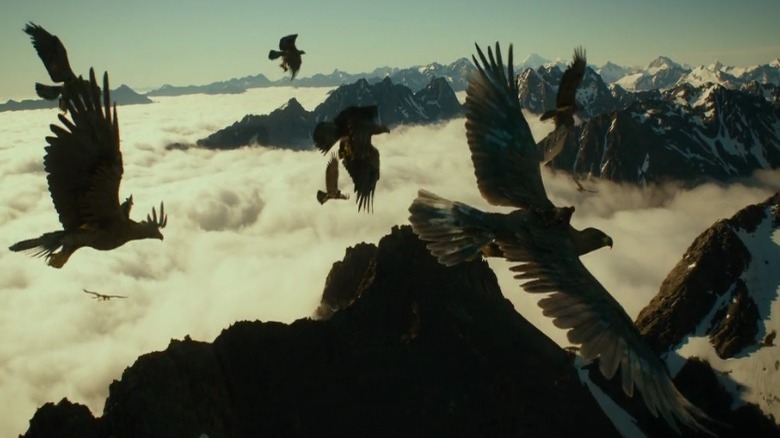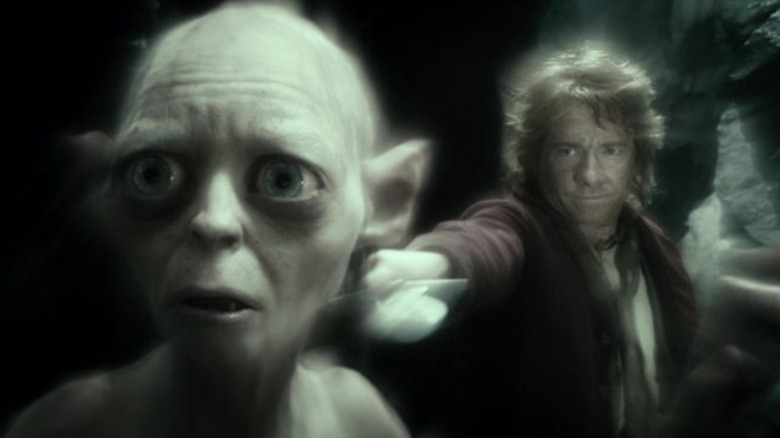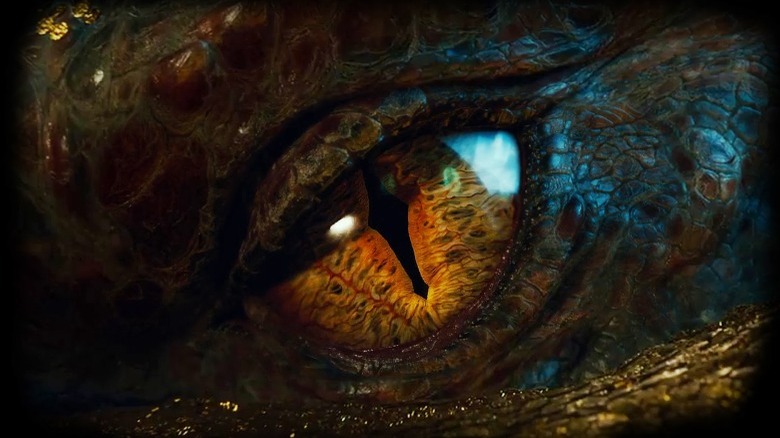The Ending Of The Hobbit: An Unexpected Journey Explained
Although it made more than a billion dollars at the box office, "The Hobbit: An Unexpected Journey" is the least heralded and most forgotten of "The Hobbit" trilogy in many ways. Since J.R.R. Tolkien's much slimmer book was adapted into three epic movies, with some supplemental material pulled from "The Silmarillon" and other places, "An Unexpected Journey" was destined to have kind of a patchwork, odd pace to it. This is even before Guillermo del Toro pulled out of directing the trilogy not long before filming before, forcing Peter Jackson to step in and direct himself instead of just producing and co-writing.
Although even Jackson himself will admit that all three movies are kind of a mess, they're still impeccably made films that offer pleasures of their own. "An Unexpected Journey" returned us, nearly a decade after "The Lord of the Rings: The Return of the King," to the lush, grandiose vision of Middle-earth that Jackson and his collaborators had established, and star Martin Freeman is perfectly cast as a younger Bilbo Baggins for the long-awaited chronicle of his adventure. If you're not a "Lord of the Rings" scholar, some of the developments in the nearly three-hour first installment might be hard to track, or perhaps you want to skip it and get straight to the more dynamic action in the second installment, "The Desolation of Smaug." Whatever your reason, here is the ending of "The Hobbit: An Unexpected Journey" explained.
No place amongst us
The only real story progression in "The Hobbit: An Unexpected Journey" is regarding Bilbo's motivation for joining the quest. The movie seems to rely on us having seen the "Lord of the Rings" trilogy to understand that Hobbits generally don't prefer to sign up for outlandish adventures, and Bilbo spends the entire movie fighting an internal battle between the two sides of his heritage. As the latest in a long line of respectable Bagginses at Bag End, he knows he'll be the talk of Hobbiton if he joins the dwarves on their quest. But as Gandalf (Ian McKellan) points out, he's also "the son of Belladonna Took," and much more prone to wildness on her side. Ultimately, when the dwarves leave without him, this side wins and he rushes to join them.
Thorin Oakenshield (Richard Armitage), the leader of the party, takes the entirety of the movie to accept that this obviously fake "burglar" belongs with the party in the first place. As Thorin rightfully points out, Bilbo often whimpers and wishes to be home in his comfortable bed, and at first serves little purpose to the company other than preventing them from having an unlucky 13 members. Even though Bilbo shows a little cunning in outsmarting the Trolls, Thorin isn't convinced that he belongs until Bilbo takes up arms and slays an Orc to save Thorin's life.
The White Council
When the party arrives at Rivendell around the halfway point of "An Unexpected Journey," Gandalf is somewhat surprised to find that Galadriel (Cate Blanchett), one of the rulers of the Elves of Lothlorien, is already there, apparently summoned on the authority of his fellow wizard Saruman the White (Christopher Lee). Once again, the movie assumes we already knows who these characters are, in addition to Elrond (Hugo Weaving), but doesn't explain how Saruman has the standing to summon lords of the Elves together. Just like "The Fellowship of the Ring," the meeting has an aura of official business about it.
It's because all of these characters are members of the White Council, a body convened thousands of years ago to deal with the evil lord Sauron the first time that he threatened Middle-earth. Saruman, at the time, was chosen to head the Council despite Galadriel's wish to have Gandalf in charge. Granted, this is all deep backstory from "The Silmarillion," but "An Unexpected Journey" asks viewers to listen to quite a bit of a White Council meeting without making the purpose of the group or the power structure all that clear. It's evident that Saruman is stuck in obstinate complacency, while Galadriel and Gandalf communicate in secret glances.
Radagast the Brown
He might not be as powerful as Gandalf or Saruman, but "The Hobbit: An Unexpected Journey" sees the triumphant cinematic debut of the wizard Radagast the Brown (Sylvester McCoy). He's generally off screen and mentioned in passing in the "Lord of the Rings" books, existing mostly to pass messages from other parties to the more central Gandalf, but Radagast is a powerful and ancient wizard in his own right. He plays a key role in this movie by tipping off the White Council to the growing power of the Necromancer in Mirkwood.
Saruman's attitude when Radagast's name comes up in the meeting is actually a key indicator of the white wizard's shifting values and (spoiler alert) eventually turn toward evil in the "Lord of the Rings" trilogy. Since Saruman is beginning to lust for power and influence, he despises Radagast's communion with the natural world as fundamentally useless. He scoffs specifically that Radagast eats "too many mushrooms," as if Radagast is some sort of Middle-earth Timothy Leary who's lost his academic credibility by turning to psychedelics. Saruman's distaste for nature also subtly foreshadows his eventual undoing at the hands (or branches) of the Ents in "The Two Towers."
The Necromancer: serious threat or Scooby-Doo villain?
The subject of the White Council meeting is Radagast's terrifying glimpse of a new and powerful figure: the Necromancer. As the audience we're privy to his experience, in which what's definitely a ghost attempts to kill him with a (real?) sword. So it's pretty frustrating to hear Saruman's reaction. He seems to think that the Necromancer is just a mortal man that's dabbling in the dark arts — even if that's the case, it still seems like something that would be worth the White Council's time to investigate. An entity so dark and powerful that locals have started referring to the area as "Mirkwood" instead of "Greenwood" is cause for alarm no matter what its origin. As it is, Gandalf and Galadriel have to have their own meeting afterwards to get anything done.
"Lord of the Rings" fans that have done their reading are well aware that the Necromancer is of course Sauron in a semi-weakened form, although Saruman dismisses this possibility directly. Even though Sauron isn't generally known for raising the dead in the later books or movie trilogy, it seems he's dabbling in it during his time in Mirkwood to drum up fear and a general sense of foreboding over the land. Even though Saruman misses the point entirely, mission definitely accomplished on the foreboding front.
The map and the door
Though it's pretty clearly explained that Thorin's general quest is to reclaim his homeland, the kingdom under the Lonely Mountain known as Erebor, "The Hobbit: An Unexpected Journey" rushes the explanation of the map he's inherited from his grandfather that will help him accomplish this. They take the map to Elrond in Rivendell, who happens to discover "moon writing" runes on it. Written by Thorin's grandfather Thror under a "silver broad crescent" moon, they can only be read under the exact same conditions. Fortunately, there's just such a moon on that exact same night, in the mother of all coincidences.
With this astounding luck, the runes reveal that on "Durin's Day" (essentially the last day of fall on the Dwarvish calendar), the last light of sunset will illuminate the keyhole of a secret door, as long as you're also standing "by the grey stone when the thrush knocks." How Thorin's grandfather knew that the bearer of the map could tell one grey stone from another, or that a thrush would knock at just the right moment, is unclear. It's also a bit confusing why Elrond had to decode this information when the map came from Thorin's own family. To be fair, it's been a hectic couple of centuries of vagrancy for all the dwarves of Erebor, so this information may have been scattered to the wind.
The Witch-King of Angmar
What makes Saruman's very "Voldemort isn't back"-esque stubbornness about the Necromancer even more disturbing is the blade that Radagast produces, a "morgul blade" that fell from the ghost that attacked him at Dol Guldur. The blade and the ghost are another giant Easter Egg for "Lord of the Rings" fans: it's none other than the Witch-King of Angmar, the leader of Sauron's nine creepy undead wraiths known as Nazgul in the later trilogy, usually seen cloaked in black and riding black horses. In "The Hobbit: An Unexpected Journey," the Witch-King is merely an apparition, as Sauron in his guise as the Necromancer isn't yet strong enough to give either himself or his most trusted servant physical form.
In any case, the blade is very real, and physical proof that the tomb of the Witch-King has been disturbed after 400 years. Even though the White Council discusses how unlikely it is, the blade combined with Radagast's eyewitness testimony seems more than compelling. Saruman nonetheless overrules it and Gandalf decides not to follow up on the entire Necromancer situation. If only the White Council held biannual elections for the top spot like a union delegation.
Is Galadriel a projection?
One of the more confusing moments in "The Hobbit: An Unexpected Journey" is a quick scene between Gandalf and Galadriel. After the largely unproductive White Council meeting, the two share a few more words on the recent Middle-earth troubles before parting ways. Instead of saying goodbye, Galadriel abruptly vanishes when Gandalf looks back up at where she was standing. Was she a projection? Is that a power that Elves have that we just weren't aware of in any of the other movies? Has she taken to silently swinging away via grappling hook mid-conversation like Batman?
One possible explanation is that it's a power of Nenya, one of the three rings given to the Elf-lords back when the Ring of Power was forged. Nenya has powers of concealment, although invisibility, like that granted by the One Ring, is never specifically mentioned as one of its effects. Galadriel has also flashed telepathic powers throughout the extended "Lord of the Rings" story, so it's not out of the question that she was somehow attending the meeting without her physical form. But it would be a bit of a stretch, based on both what we know of elven powers in the films and in Tolkien's universe. As it is, it's a small and inscrutable moment in "An Unexpected Journey" that we just have to sit with. Maybe it's just that Gandalf has been smoking a little too much pipe-weed from the Shire after all.
One ring to not even mention
The most fateful moment in "The Hobbit: An Unexpected Journey" is when Bilbo happens upon a golden ring in the caverns under the Misty Mountains. He accidentally puts it on, only to discover that it makes him invisible to the nefarious Gollum (Andy Serkis). "Lord of the Rings" fans recognize this immediately as the One Ring to rule them all, the key to Sauron's power. With Sauron in his still-weakened state off in Mirkwood, Bilbo has a much more relaxed time using the ring than his nephew Frodo will have in the future, as he's not troubled by any visions of Sauron's fiery, unblinking eye. It's doubtful that Sauron is even aware of its discovery at this point in time.
It's also key that Bilbo chooses not to reveal the ring to the rest of Thorin's company. In the book version of "The Hobbit," this is because he's a little more interested in maintaining his fabricated reputation as a burglar capable of operating stealthily. But in "An Unexpected Journey," the moment is played differently: Martin Freeman expertly imitates a physical habit Ian Holm established as the older Bilbo and absentmindedly rubs the ring while it's in his pocket, indicating that the insidious power of the ring has already begun to work on him.
The moth/eagle emergency hotline
One of the most frequently complained about and generally confusing moments in the "Lord of the Rings" trilogy is the rescue at the end of "The Return of the King" by the Great Eagles. It won't help that "The Hobbit: An Unexpected Journey" continues this tradition by also having the Eagles arrive just in the nick of time to save Thorin and company from Azog the Defiler at the end, nor that they're summoned almost in real time by Gandalf communicating with a moth, as he does in "The Fellowship of the Ring."
Generally the issue in both movie trilogies is that no time is devoted to explaining that the eagles are sentient, proud beings that have a special relationship with wizards in the theology of Middle-earth, and in fact are very similar to Gandalf himself in that they were sent to Middle-earth from the quasi-mythical realm of Valinor across the sea. In other words the eagles and wizards are somewhat angelic figures that serve higher purposes of destiny and fate in a sort of cosmic sense. As a result, like Gandalf himself, they often arrive just in the nick of time in a kind of inexorable fashion that it's better to just accept as part of fantasy storytelling than think too hard about.
When not to take a life
As Gandalf explains to Bilbo, true courage is knowing when not to take a life, not just when to take one. Bilbo's decision to spare the life of the wretched but pitiable Gollum will prove to be the most fateful act in the entire "Hobbit" trilogy. Even more than the fate of Smaug or the outcome of the Battle of Five Armies, Gollum's path will lead him all across Middle-earth and back, and eventually to the edge of the fires of Mount Doom and the One Ring's accidental destruction.
This act of mercy drives home a theme about Hobbits and their modest, peaceful instincts that's central to both trilogies. Even with the ring already working on his moral compass, Bilbo can't bring himself to kill the vile creature that wants to take it back from him — eventually Bilbo will become the only ringbearer to willingly part with the dreaded artifact when he passes it on to Frodo. In turn, Gollum, who was once a very Hobbit-like riverfolk named Smeagol, is key in keeping the ring hidden from Sauron for centuries. Even though he's fully under the ring's spell, he's content to hide away with it in caverns instead of seeking power of any sort.
Smaug and his Scrooge McDuck bath
The last image of "The Hobbit: An Unexpected Journey," just after Bilbo foolishly says that the "worst is behind" the traveling company, is a glimpse of the terror that awaits them in the next movie as we get a glimpse of the immense dragon Smaug. Sleeping under a literal mountain of gold, Smaug is disturbed by the knocking of a thrush, a portent of what's to come when the company arrives on Durin's Day to really cause him trouble.
It's well-established in Tolkien's world that dragons all have an insatiable lust for gold, sometimes to the exclusion of even food, but it's never quite explained why. Dragons were created by the dark lord Morgoth (Sauron's even more powerful original master) and set loose upon the world, so their lust for gold may have been a way to destabilize the kingdoms of dwarves and men en masse in Morgoth's campaign of terror. Centuries and centuries after Morgoth's defeat, Smaug still roams the earth and sets off the events of "The Hobbit" by storming Erebor.
